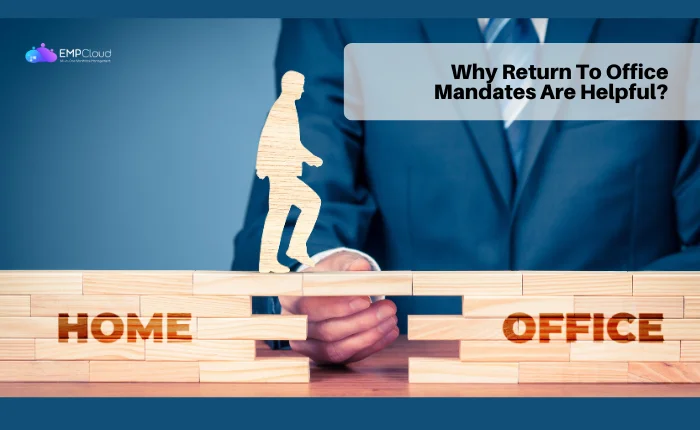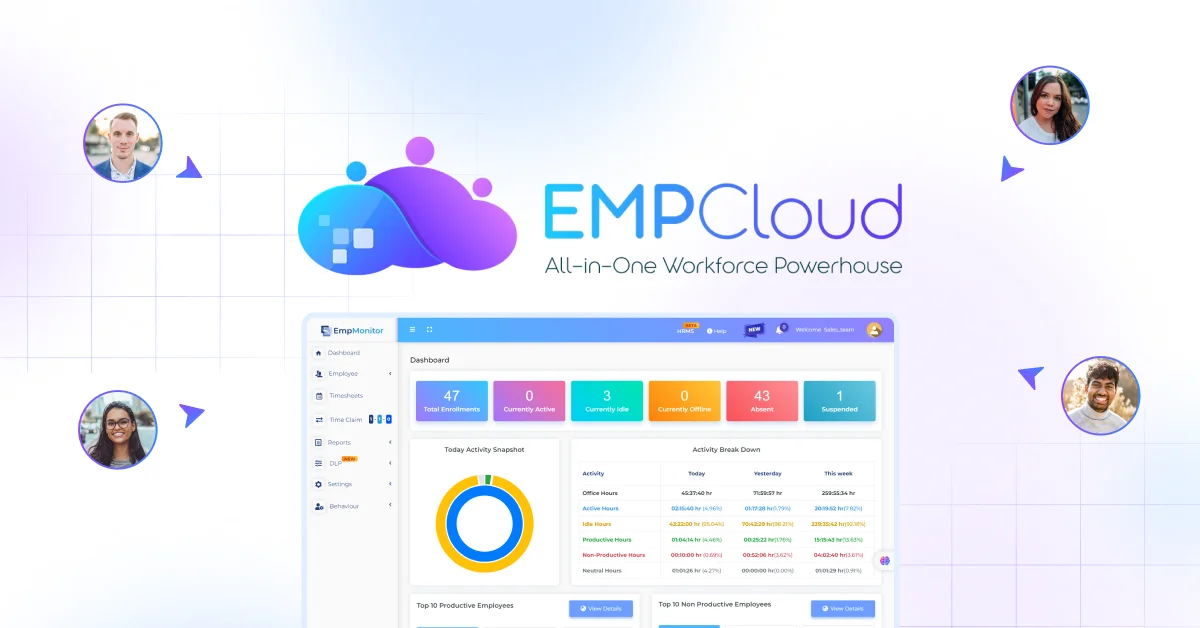
Many organizations face challenges keeping teams aligned in a hybrid or remote setup. Return to office mandates help managers and higher stakeholders ensure better communication, collaboration, and oversight. Bringing employees back on-site strengthens workplace culture and keeps everyone focused on business goals.
For employers, it’s easier to monitor productivity, guide teams, and resolve issues in real time. Office presence also sparks spontaneous collaboration and stronger relationships among colleagues.
By implementing RTO mandates, companies create a structured environment where employees feel engaged and connected, helping leaders drive performance and long-term growth.
In A Hurry? Listen To The Blog Instead-
What’s The Changing Landscape of Work?
The way we work has undergone a massive shift, redefining how organizations operate, lead, and grow. What started as a global experiment in remote work has now evolved into a long-term transformation that continues to challenge business leaders worldwide. For employers and managers, understanding this changing landscape is key to shaping strategies that foster collaboration, accountability, and sustained success.
1. Rapid Transformation in Workplace Dynamics
In just a few years, the workplace has changed more than it did in decades. Remote work software, once viewed as a temporary adjustment, has become a lasting preference for many employees. However, leaders are increasingly realizing that extended remote setups often dilute collaboration and weaken accountability. For managers aiming to maintain team cohesion and high performance, this shift requires new levels of adaptability and leadership.
2. The Need for Balance Between Flexibility and Structure
Organizations are now searching for a healthy balance between flexibility and structure. While digital tools allow teams to stay connected virtually, they can’t fully replace the spark of creativity that comes from in-person collaboration. Leaders understand that a shared workspace strengthens communication, teamwork, and trust—all vital for long-term success.
To restore that balance, many companies are reintroducing return to office mandates—not as restrictions, but as initiatives to rebuild connection and consistency within their teams. These mandates allow managers to oversee work more effectively while ensuring employees remain aligned with organizational goals.
3. Rebuilding Company Culture and Collaboration
Company culture has become one of the most important assets for any business. Employers recognize that personal interactions foster a stronger sense of belonging, faster trust-building, and more open communication. In-person teamwork encourages creative problem-solving and reinforces shared values that define an organization’s identity.
By focusing on physical collaboration spaces, leaders create opportunities for innovation, mentorship, and growth. This is why many executives view rto mandates as essential steps toward restoring culture, boosting engagement, and improving team performance.
4. Embracing Hybrid Models for the Modern Workforce
Flexibility, however, remains crucial in today’s work environment. Forward-thinking leaders are blending remote convenience with on-site collaboration through hybrid work models. This approach provides employees the freedom they value while helping employers maintain productivity and alignment.
Such hybrid frameworks show that return to office mandates can coexist with flexibility. When implemented thoughtfully, they encourage accountability, strengthen collaboration, and ensure employees feel both trusted and supported in their roles.</p>
5. Looking Ahead: Building a Connected Future
As workplaces continue to evolve, employers must focus on strategies that combine structure with empathy. The goal is to create environments that drive engagement, innovation, and growth while supporting employee well-being.
By adopting purposeful return to work mandates, organizations can ensure their teams remain connected, motivated, and ready to thrive in the new world of work—one that values both flexibility and human connection.
What Are Return To Office Mandates?
RTO mandates are policies that guide employees on when and how to resume on-site work. They are designed to restore structure, collaboration, and engagement that remote work often dilutes. For managers and business leaders, these mandates provide a clear framework to ensure teams stay aligned with organizational goals while maintaining productivity.
Such mandates vary depending on company needs. Some organizations require full-time in-office presence, while others adopt hybrid schedules to balance flexibility with oversight. The main purpose remains consistent: enabling leaders to supervise, support, and connect with their teams more effectively. By clearly defining expectations, return to office mandates reduce confusion and enhance accountability across departments.
Beyond operational oversight, these mandates strengthen workplace culture. In-person interactions foster mentorship, collaboration, and trust that digital platforms alone cannot replicate. Tools like EmpCloud help managers monitor productivity and team engagement, ensuring that employees who transition back to office adapt smoothly without disrupting workflows.
Effective rto mandates are not about enforcing rigid rules—they are about creating environments where employees and leaders thrive together. They allow higher stakeholders to maintain strategic control while promoting engagement, innovation, and consistent performance throughout the organization.
Why Return To Office Mandates Are Helpful?
As organizations navigate the post-pandemic workplace, leaders are realizing that structured in-office policies can drive collaboration, culture, and productivity like never before.
1. Improve Team Collaboration
Face-to-face interactions foster faster communication, better decision-making, and stronger teamwork. Employees brainstorm ideas, solve problems, and share knowledge more effectively in person. Implementing return to office mandates ensures that teams collaborate efficiently and maintain momentum on critical projects.
2. Strengthen Company Culture
In-person presence reinforces organizational values, builds trust, and promotes engagement. Regular interactions help employees feel connected to the company’s vision. A clear rto policy allows managers to create a consistent culture while respecting employee flexibility.
3. Enhance Accountability and Oversight
Managers gain direct visibility into employee performance and workflow. They can monitor progress, provide guidance, and address challenges in real time. Return to office mandates create a structured environment where higher stakeholders can ensure teams remain aligned with business objectives.
4. Foster Employee Development and Mentorship
On-site work allows leaders to mentor employees, guide skill development, and share knowledge spontaneously. Informal conversations and hands-on training contribute to professional growth. These benefits are harder to achieve with fully remote setups, making rto mandates essential for long-term team growth.
5. Increase Productivity and Focus
A structured workspace minimizes remote distractions and encourages focused work. Employees are more engaged, responsive, and productive when they work in a collaborative environment. By implementing return to office mandates, companies maintain performance standards while supporting employee efficiency.
6. Rebuild Engagement and Morale
Being together physically helps employees feel valued, motivated, and part of a team. Social interactions, recognition, and shared achievements strengthen morale. Leaders can leverage return to office mandates to foster a positive workplace experience that boosts retention.
7. Support Strategic Business Goals
Bringing teams back on-site allows higher stakeholders to align resources, monitor outcomes, and drive business growth. Tools like EmpCloud help track productivity and engagement, making return to office mandates easier to implement without micromanagement.
What Are The Challenges of Enforcing Return-to-Office Mandates?
While many organizations are eager to bring employees back on-site, enforcing return-to-office mandates presents unique challenges for leaders and managers. Let’s understand the challenges-
1. Passive Resistance from Employees
Even when companies announce return to office mandates, many employees do not follow through fully. Middle managers may avoid enforcing rules if team performance remains strong, and senior leadership may overlook minor exceptions. This “compliance gap” creates a disconnect between policy and practice, making enforcement difficult.
2. Limited Middle Management Capacity
Many organizations have reduced middle management layers, which can lead to burnout for remaining managers. Overloaded managers may struggle to enforce return to office mandates consistently, further widening the compliance gap and reducing accountability across teams.
3. Difficulty in Tracking Attendance
Companies often struggle to monitor whether employees meet required in-office days. Hybrid workers may attend partially, take client meetings, or engage in “coffee badging”—coming in for a few hours to show presence. These behaviors make it challenging to enforce return to office mandates fairly and accurately.
4. Balancing Flexibility with Compliance
Employees prioritize flexibility and experiment with schedules, micro-shifting, or personal appointments during office days. Strict enforcement of return to office mandates without accommodating flexibility risks dissatisfaction and lowers engagement. Managers need strategies that balance structure and autonomy.
5. Risk of Losing Skilled Employees
Employees may quit if RTO policies conflict with their personal or professional needs. Research shows that women, senior staff, and highly skilled workers are most likely to leave under rigid mandates. Poorly enforced return to office mandates can inadvertently drive away top talent.
6. Challenges in Implementing Policy Efficiently
Enforcing a return to office policy requires monitoring, accountability, and timely interventions. Without proper systems, managers may rely on guesswork or inconsistent enforcement, reducing the effectiveness of RTO initiatives.
7. Leveraging Technology for Solutions
Platforms like EmpCloud help employers and managers track attendance, monitor engagement, and implement return to office mandates. Technology ensures compliance while maintaining employee flexibility, protecting culture, and aligning teams with organizational goals.
Read More
20 Ways Remote Work Software Can Boost Team Productivity
Why Is Time Attendance Software Crucial For Efficient Business?
How EmpCloud Helps You Overcome Return To Office Mandates?
Before exploring how EmpCloud can help enforce return to office mandates, it’s essential to understand what EmpCloud is. EmpCloud is a comprehensive workforce management suite designed to track attendance, monitor productivity, and improve employee engagement. It provides managers and higher stakeholders with actionable insights, enabling them to implement office policies efficiently while supporting team flexibility and morale.
Let’s see how to overcome these challenges with EmpCloud-
-
Smart Attendance & Check-In System
EmpCloud tracks in-office presence in real time, reducing the compliance gap and discouraging partial attendance or “coffee badging.” Managers can ensure teams meet return to office mandates efficiently.
2. Flexible Hybrid Scheduling
The platform allows employees to manage hybrid schedules while helping managers enforce minimum office days. This promotes flexibility without compromising organizational policies.
3. Productivity Monitoring & Insights
EmpCloud provides detailed productivity reports, helping managers identify workflow bottlenecks and measure team output. Data-driven insights ensure return to office mandates contribute to higher efficiency.
4. Engagement & Collaboration Tracking
The tool measures team interactions, collaboration, and employee engagement, allowing leadership to understand how in-office presence improves culture, mentorship, and teamwork.
5. Policy Automation & Alerts
EmpCloud automates policy enforcement with notifications, reminders, and dashboards. Managers can monitor compliance with a return to office policy seamlessly without micromanagement.
6. Analytics for HR & Leadership
EmpCloud delivers actionable insights to refine office policies, optimize workspace utilization, and identify retention risks, ensuring RTO strategies align with business objectives.
7. Seamless Integration & User-Friendly Interface
EmpCloud integrates with existing HR and productivity tools. It offers a smooth experience for managers and employees. This ensures return to office mandates are implemented efficiently and transparently.
Best Practices for Implementing Return To Office Mandates?
Implementing return-to-office mandates successfully requires strategy, flexibility, and a focus on making the office environment rewarding. Let’s see the best practices-
1. Communicate the “Why” Clearly
Explain the purpose and strategic reasoning behind return to office mandates. When employees understand how in-office collaboration supports business goals, productivity, and company culture, they are more likely to comply. Clear communication builds trust and reduces resistance.
2. Offer Flexibility Where Possible
Allow hybrid or phased approaches to make transitions smoother. Employees benefit from balancing remote work with in-office days, ensuring comfort while meeting organizational objectives. Flexibility enhances engagement and reduces pushback when implementing return to office mandates.
3. Focus on Employee Experience
Make returning to the office rewarding by improving workspace quality, organizing team lunches, and hosting engagement events. A positive experience encourages employees to embrace return to office mandates, fostering collaboration and reinforcing company culture.
4. Lead by Example
Leadership presence in the office sets the tone for the rest of the organization. When managers and executives actively follow return-to-office mandates, employees see their importance and are more likely to participate consistently.
5. Use Technology to Support Transition
Leverage tools for time attendance tracking, collaboration, and hybrid scheduling to simplify implementation. Platforms like EmpCloud help managers monitor compliance and engagement, making return to office mandates easier to enforce while maintaining productivity and flexibility.
The Bottom Line
In today’s hybrid work environment, return-to-office mandates play a crucial role in maintaining collaboration, productivity, and company culture. For employers and managers, they offer a structured approach to monitoring performance, supporting employee development, and fostering stronger team connections.
These mandates balance flexibility with accountability when implemented thoughtfully. It ensures employees feel engaged and motivated. Tools like EmpCloud make enforcing office policies seamless, providing data-driven insights, time attendance tracking, and hybrid schedule management. By combining clear communication, leadership involvement, and technology support, organizations can make the transition back to the office smooth and rewarding.
Ultimately, return to office mandates strengthen organizational alignment, drive business goals, and create a more connected, productive workforce.
Frequently Asked Questions-
Q: Do return to office mandates affect employee morale?
When implemented thoughtfully with engagement initiatives, flexibility, and rewards, they can improve morale, collaboration, and a sense of belonging among employees.
Q. Are return to office mandates the same as a return to office policy?
Not exactly. A return to office policy outlines the formal rules and expectations, while return to office mandates enforce those requirements to ensure compliance.
Q: Can return to office mandates impact retention?
When implemented without flexibility, rigid mandates may lead to attrition among senior, skilled, or female employees. Thoughtful policies with support and engagement can minimize this risk.





